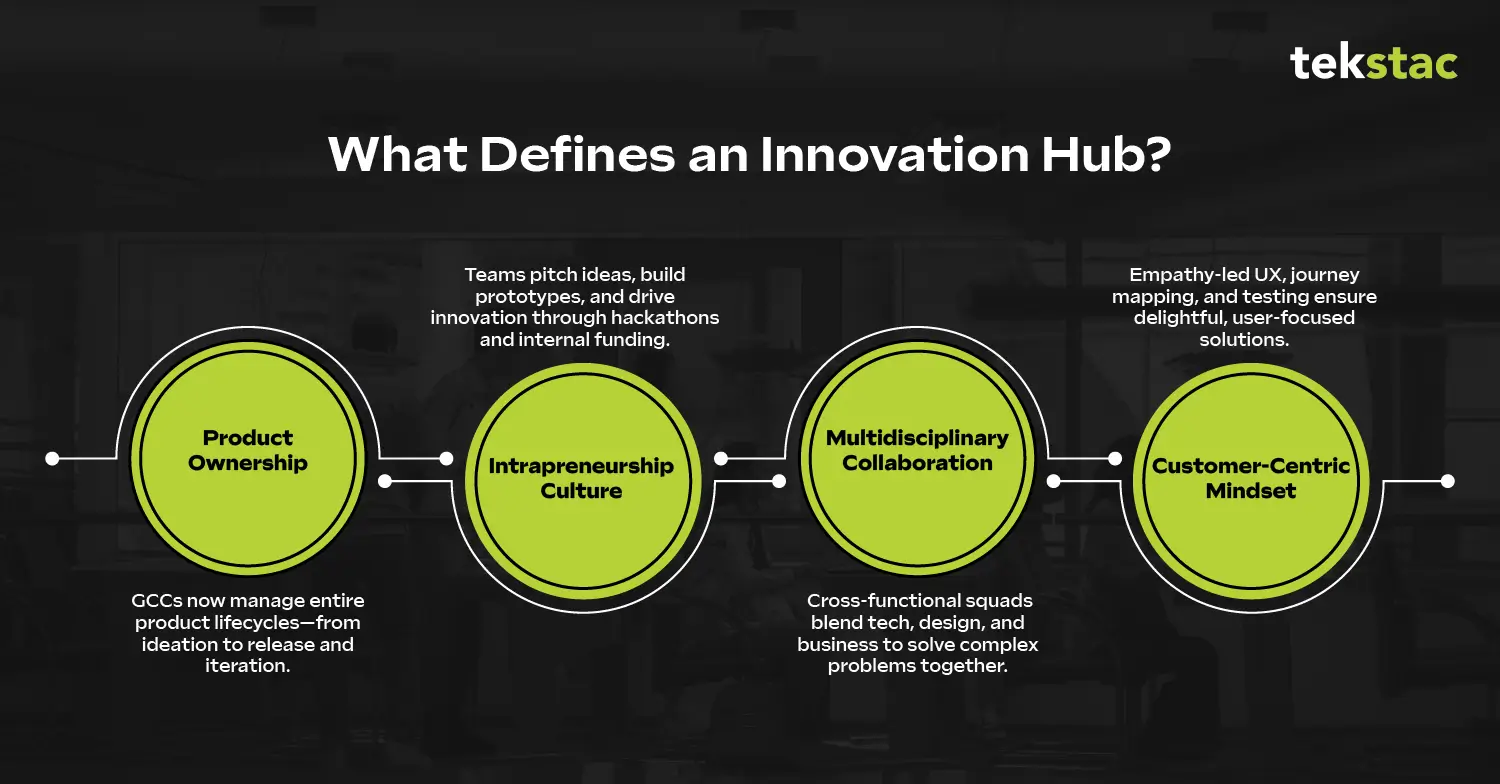CXO Insights: How GCCs Are Becoming Global Innovation Hubs
July 17, 2025

The Evolution of GCCs
Global Capability Centers (GCCs) were once primarily cost-saving arms for multinational corporations, handling back-office operations like IT support, finance, and HR. But the landscape has shifted dramatically. Today, these centers are transforming into dynamic innovation hubs, driving digital transformation, customer experience strategies, and AI-led growth initiatives.
This evolution is backed by hard data: according to a 2024 McKinsey survey, 63% of global CXOs say their GCCs are now central to innovation and not just execution. Moreover, Bain & Company’s 2024 GCC Outlook reveals that over 60% of GCCs are expected to manage end-to-end digital product portfolios by 2027.
These are no longer back-end functions- they’re strategic frontlines. For CXOs, the message is clear: the next wave of innovation will be orchestrated from these hubs, not just headquarters.
Why the Shift from Cost to Innovation?
1. The Talent Advantage
One of the foremost drivers of this shift is the availability of high-quality, innovation-ready talent in GCC locations. Countries like India, Poland, the Philippines, and Mexico boast a rich pool of engineers, data scientists, UX designers, and domain experts. These professionals are not just executioners; they are creators. GCCs have evolved into hubs where design thinking, AI/ML experimentation, and digital product development thrive.
“Our India GCC is no longer just a delivery arm. It’s where some of our most groundbreaking AI models are being built and tested.” – CTO, Global Retail Conglomerate
2. Technology Democratization
Advancements in cloud computing, AI, low-code platforms, and collaborative tools have made it easier for distributed teams to co-create and deploy solutions globally. GCCs, empowered with access to the same tools and platforms as headquarters, now participate in high-impact innovation projects from day one.
3. Strategic Mandates from CXOs
Forward-thinking CXOs are increasingly issuing mandates for GCCs to lead in specific innovation areas. Whether it’s building AI capabilities, launching new digital products, or experimenting with new business models, GCCs are being positioned as co-owners rather than implementers.
4. The Pandemic Push
COVID-19 forced rapid digital transformation. Enterprises had to pivot overnight, and GCCs became crucial in ensuring business continuity and innovation agility. Many organizations realized that these centers could deliver more than support- they could lead transformation.
What Defines an Innovation Hub?
Innovation Hubs are not just about ideas; they are about execution at scale. GCCs that operate as innovation hubs share the following characteristics:

1. Product Ownership
GCCs are no longer just contributors to product development- they own product lifecycles. From ideation to release and iteration, they manage global digital platforms and services.
2. Intrapreneurship Culture
Innovation hubs promote a culture of intrapreneurship. Teams within GCCs are encouraged to identify problems, pitch solutions, and prototype products. Internal hackathons, innovation funds, and sandbox environments fuel this ecosystem.
3. Multidisciplinary Collaboration
Successful innovation hubs bring together diverse talent- engineers, designers, marketers, and business analysts, to collaborate on solving complex problems. GCCs are building integrated squads that mimic startup-like environments.
4. Customer-Centric Mindset
GCCs are investing in ethnographic research, journey mapping, and UX testing to ensure solutions are not just functional but delightful. Empathy-led design is now a core philosophy.
Industry Examples
Retail
Target’s GCC in Bangalore is a prime example of a successful innovation hub. The center has developed supply chain optimization algorithms, AI-driven product recommendations, and mobile app enhancements that have directly impacted customer experience and revenue.
Banking
JPMorgan Chase’s global centers are leading the charge in blockchain experimentation, fraud detection algorithms, and personalized financial advisory bots- much of this driven by their offshore teams.
Healthcare
Philips and GE Healthcare have expanded their GCCs in India to include R&D labs. These centers are now responsible for building diagnostic imaging algorithms and digital health solutions that are deployed globally.
The Role of CXOs in Driving This Shift
1. Vision and Intent
The transformation of GCCs into innovation hubs begins with leadership intent. CXOs must communicate a bold vision and empower their GCCs with the autonomy and budget to pursue it.
2. Flattened Structures
Hierarchical bottlenecks kill innovation. Successful CXOs are redesigning governance models to reduce dependencies and allow faster decision-making within GCCs.
3. Integrated KPIs
Rather than evaluating GCCs on cost savings or SLA adherence, CXOs are introducing innovation KPIs like patents filed, products launched, adoption metrics, and user satisfaction scores.
4. Global-Local Synergy
Innovative GCCs have direct access to business stakeholders and markets. CXOs are facilitating this by embedding GCC leads into global leadership forums and ensuring seamless collaboration across regions.
What Holds Innovation Hubs Back—and How to Fix It
Despite the momentum, certain challenges persist:
1. Legacy Perceptions
Many stakeholders still view GCCs as cost-saving mechanisms. Changing this narrative requires constant internal communication, success stories, and leadership advocacy.
2. Talent Drain
As the demand for digital skills rises, so does attrition. Innovation hubs need to create compelling employee value propositions, offering growth, global exposure, and impact.
3. Lack of Customer Proximity
Some GCCs struggle with understanding customer needs due to geographical distance. Investing in market immersion programs, customer interviews, and real-time feedback loops is essential.
The Future of GCCs as Innovation Hubs
1. AI and Automation Leadership
GCCs are poised to lead AI experimentation and automation at scale. From generative AI applications to process re-engineering bots, these hubs will be central to intelligent enterprise evolution.
2. Sustainability Innovation
Many GCCs are now tasked with designing ESG dashboards, carbon accounting systems, and green supply chain solutions. Innovation is no longer just about tech, it’s about purpose.
3. From Hubs to Orchestrators
The next frontier is not just about innovation within GCCs but orchestrating innovation across ecosystems– startups, academia, government, and other corporate partners.
The Strategic Imperative
The shift from cost center to innovation hub is not a trend, it’s a strategic imperative. For CXOs, the question is no longer whether GCCs can drive innovation, but how to scale and sustain this transformation.
Enterprises that embrace this shift will enjoy faster time-to-market, deeper customer insights, and resilient digital platforms. More importantly, they will tap into the collective brilliance of global talent to solve problems that matter.
GCCs are no longer the back office. They are the brain trust.





